Spatiotemporal Deep Learning to Forecast Storm Surge Water Levels and Storm Trajectory: Case Study Hurricane Harvey
Abstract
1. Introduction
- Establish a surrogate model of ADCIRC+SWAN (multiple nodes with multiple features). The model utilizes the storm surge results of Hurricane Harvey, generated by ADCIRC+SWAN, as data and selects an area in the Gulf of Mexico near Houston as the region of interest to predict up to 12 h of water elevation. Input time-varying meteorological forcing data (like past wind speed and pressure, water elevations, and velocities), static nodal geographic and topographic data (i.e., bathymetry and Manning’s n), and the output is the time-varying water elevation of each node. Compare the target with the predictions for the next 3, 6, 9, and 12 h.
- Forecast water level changes at observation stations (multiple nodes with a single feature). The study selected water level changes at 12 observation stations in the waters near Texas for up to 9 h of prediction and compared them with the observed data, as well as with ADCIRC+SWAN model results.
- Forecast the trajectory and attributes of Hurricane Harvey (single node with multiple features), including 1, 6, and 12 h prediction of latitude, longitude, wind velocity, atmospheric pressure, categories, storm speed, and storm direction, and compare with the observed data.
2. Methodology
2.1. Datasets
2.1.1. Storm Surge Results from ADCIRC+SWAN
2.1.2. Buoy Data
2.1.3. Track Data
2.2. Feature Engineering
- Time Series: The three datasets treat time series in distinct ways: (1) As a surrogate for ADCIRC+SWAN, the model relies primarily on historical water elevation, including wave contribution with it, to forecast future levels, while incorporating additional features—such as water velocity, wind velocity, and atmospheric pressure—to capture causal relationships and improve accuracy. (2) As an observation-station water level predictive model, it predicts future water levels from each station’s historical time series. Because all stations are affected by the same hurricane, they are connected, forming a multi-node, single-feature time series. (3) As a hurricane trajectory and property prediction model, the time-series features are sourced from historical and geographical data, including wind speed, pressure, forward speed, and direction. A hurricane is represented as a single node whose location and attributes evolve over time, with both inputs and outputs expressed as time series of this multi-feature node.
- Spatial Feature: Only the datasets produced by the ADCIRC+SWAN simulation and the buoy records from observation stations contain this feature. As demonstrated in Figure 2, the ADCIRC mesh explicitly defines the geolocation of each node, whereas Table 1 clearly specifies the geographical coordinates of the observation stations. These location data cannot be directly incorporated into the model; instead, they must influence the model parameters through learnable embeddings [47].
- Static Features: Only used in the storm surge data of ADCIRC+SWAN. The nodal attributes, such as bathymetry and Manning’s n are two essential static input conditions for accurate hydrodynamic simulations. These static factors do not change over time, we use them as coefficients to transform them into learnable embeddings through the fully connected layer.
- Temporal Feature This feature is applied in the surrogate model of ADCIRC+SWAN and in forecasting water levels at observation stations, drawing on approaches originally introduced in traffic forecasting based on temporal variations in traffic volume [48]. Similarly, fluctuations in water level are partly driven by regular tidal cycles, which depend on the time of day. Experimental results demonstrate that model accuracy can be further enhanced by constructing a learnable matrix to generate temporal embeddings that capture the influence of tides on water levels across different times of the day.
2.3. Model
2.3.1. Embedding Layer
- Time Series Embedding
- Topographic Embeddings
- Temporal embedding
- Spatial embedding
- Concatenate
2.3.2. Feature Fusion and Extraction Layer
2.3.3. Regression Layer
2.4. Evaluation Metrics
2.5. Experiment
3. Results and Discussion
3.1. Surrogate Model of ADCIRC+SWAN
3.1.1. Ablation Experiment of the Input Layer
3.1.2. Module Substitution Experiments
3.2. Water Level Prediction of Observation Stations
3.3. Prediction of Hurricane Track and Attributes
3.4. Summary of Innovation
4. Conclusions
Author Contributions
Funding
Data Availability Statement
Acknowledgments
Conflicts of Interest
References
- NOAA’s National Weather Service. Major Hurricane Harvey—25–29 August 2017. Available online: https://www.weather.gov/crp/hurricane_harvey (accessed on 26 January 2025).
- Freedman, A. As Texas Flooded, Meteorologists Felt Helpless as Dire Forecasts Were Realized. Mashable. 30 August 2017. Available online: https://mashable.com/article/harvey-flood-left-forecasters-helpless-accurate (accessed on 11 September 2025).
- Kubarek, D. Data Assimilation Method Offers Improved Hurricane Forecasting. PennState. 15 August 2019. Available online: https://www.psu.edu/news/research/story/data-assimilation-method-offers-improved-hurricane-forecasting (accessed on 23 March 2025).
- Schumacher, R. What Made the Rain in Hurricane Harvey so Extreme? The Conversation. 29 August 2017. Available online: https://theconversation.com/what-made-the-rain-in-hurricane-harvey-so-extreme-83137 (accessed on 23 March 2025).
- Jenkinson, A.F. The frequency distribution of the annual maximum (or minimum) values of meteorological elements. Q. J. R. Meteorol. Soc. 1955, 81, 158–171. [Google Scholar] [CrossRef]
- Hsu, C.-H.; Olivera, F.; Irish, J.L. A hurricane surge risk assessment framework using the joint probability method and surge response functions. Nat. Hazards 2018, 91, 7–28. [Google Scholar] [CrossRef]
- Fleming, J.G.; Fulcher, C.W.; Luettich, R.A.; Estrade, B.D.; Allen, G.D.; Winer, H.S. A Real Time Storm Surge Forecasting System Using ADCIRC. In Estuarine and Coastal Modeling (2007); American Society of Civil Engineers: Reston, VA, USA, 2008; pp. 893–912. [Google Scholar]
- Hope, M.E.; Westerink, J.J.; Kennedy, A.B.; Kerr, P.C.; Dietrich, J.C.; Dawson, C.; Bender, C.J.; Smith, J.M.; Jensen, R.E.; Zijlema, M.; et al. Hindcast and validation of Hurricane Ike (2008) waves, forerunner, and storm surge. J. Geophys. Res. Oceans 2013, 118, 4424–4460. [Google Scholar] [CrossRef]
- Jelesnianski, C.P.; Chen, J.; Shaffer, W.A. SLOSH: Sea, Lake, and Overland Surges from Hurricanes; U.S. Department of Commerce’s National Oceanic and Atmospheric Administration’s National Weather Service: Silver Spring, MD, USA, 1992; Volume 48. [Google Scholar]
- Luettich, R.A., Jr.; Westerink, J.J.; Scheffner, N.W. ADCIRC: An Advanced Three-Dimensional Circulation Model for Shelves Coasts and Estuaries, Report 1: Theory and Methodology of ADCIRC-2DDI and ADCIRC-3DL; Dredging Research Program Technical Report DRP-92-6; US Army Engineers Waterways Experiment Station: Vicksburg, MS, USA, 1992; 137p. [Google Scholar]
- Roelvink, J.A.; Van Banning, G. Design and development of DELFT3D and application to coastal morphodynamics. In Hydroinformatics; Balkema: Rotterdam, The Netherlands, 1994; pp. 451–455. [Google Scholar]
- Zhang, Y.J.; Ye, F.; Stanev, E.V.; Grashorn, S. Seamless cross-scale modeling with SCHISM. Ocean Model. 2016, 102, 64–81. [Google Scholar] [CrossRef]
- Fernández-Cabán, P.L.; Alford, A.; Bell, M.J.; Biggerstaff, M.I.; Carrie, G.D.; Hirth, B.; Kosiba, K.; Phillips, B.M.; Schroeder, J.L.; Waugh, S.M.; et al. Observing Hurricane Harvey’s Eyewall at Landfall. Bull. Am. Meteorol. Soc. 2019, 100, 759–775. [Google Scholar] [CrossRef]
- Wing, O.E.; Sampson, C.C.; Bates, P.D.; Quinn, N.; Smith, A.M.; Neal, J.C. A flood inundation forecast of Hurricane Harvey using a continental-scale 2D hydrodynamic model. J. Hydrol. X 2019, 4, 100039. [Google Scholar] [CrossRef]
- Costa, W.; Bryan, K.R.; Stephens, S.A.; Coco, G. A regional analysis of tide-surge interactions during extreme water levels in complex coastal systems of Aotearoa New Zealand. Front. Mar. Sci. 2023, 10, 1170756. [Google Scholar] [CrossRef]
- Olabarrieta, M.; Warner, J.C.; Armstrong, B.; Zambon, J.B.; He, R. Ocean–atmosphere dynamics during Hurricane Ida and Nor’Ida: An application of the coupled ocean–atmosphere–wave–sediment transport (COAWST) modeling system. Ocean Model. 2012, 43, 112–137. [Google Scholar] [CrossRef]
- Spicer, P.; Huguenard, K.; Ross, L.; Rickard, L.N. High-frequency tide-surge-river interaction in estuaries: Causes and implications for coastal flooding. J. Geophys. Res. Oceans 2019, 124, 9517–9530. [Google Scholar] [CrossRef]
- Butler, T.; Altaf, M.U.; Dawson, C.; Hoteit, I.; Luo, X.; Mayo, T. Data Assimilation within the Advanced Circulation (ADCIRC) Modeling Framework for Hurricane Storm Surge Forecasting. Mon. Weather Rev. 2012, 140, 2215–2231. [Google Scholar] [CrossRef]
- Gharehtoragh, M.A.; Johnson, D.R. Using surrogate modeling to predict storm surge on evolving landscapes under climate change. NPJ Nat. Hazards 2024, 1, 1–9. [Google Scholar] [CrossRef]
- Kim, S.-W.; Melby, J.A.; Nadal-Caraballo, N.C.; Ratcliff, J. A time-dependent surrogate model for storm surge prediction based on an artificial neural network using high-fidelity synthetic hurricane modeling. Nat. Hazards 2014, 76, 565–585. [Google Scholar] [CrossRef]
- Ramos-Valle, A.N.; Curchitser, E.N.; Bruyère, C.L.; McOwen, S. Implementation of an Artificial Neural Network for Storm Surge Forecasting. J. Geophys. Res. Atmos. 2021, 126, e2020JD033266. [Google Scholar] [CrossRef]
- Krige, D.G. A statistical approach to some basic mine valuation problems on the Witwatersrand. J. S. Afr. Inst. Min. Metall. 1951, 52, 119–139. [Google Scholar]
- Babovic, V.; Keijzer, M. A Gaussian process model applied to prediction of the water levels in Venice lagoon. In Proceedings of the Congress-International Association for Hydraulic Research, Beijing, China, 16–21 September 2001; pp. 509–513. [Google Scholar]
- Jia, G.; Taflanidis, A.A. Kriging metamodeling for approximation of high-dimensional wave and surge responses in real-time storm/hurricane risk assessment. Comput. Methods Appl. Mech. Eng. 2013, 261–262, 24–38. [Google Scholar] [CrossRef]
- Yang, K.; Paramygin, V.A.; Sheng, Y.P. A Rapid Forecasting and Mapping System of Storm Surge and Coastal Flooding. Weather. Forecast. 2020, 35, 1663–1681. [Google Scholar] [CrossRef]
- Alemany, S.; Beltran, J.; Perez, A.; Ganzfried, S. Predicting Hurricane Trajectories Using a Recurrent Neural Network. Proc. AAAI Conf. Artif. Intell. 2019, 33, 468–475. [Google Scholar] [CrossRef]
- Bowes, B.D.; Sadler, J.M.; Morsy, M.M.; Behl, M.; Goodall, J.L. Forecasting Groundwater Table in a Flood Prone Coastal City with Long Short-term Memory and Recurrent Neural Networks. Water 2019, 11, 1098. [Google Scholar] [CrossRef]
- Igarashi, Y.; Tajima, Y. Application of recurrent neural network for prediction of the time-varying storm surge. Coast. Eng. J. 2021, 63, 68–82. [Google Scholar] [CrossRef]
- Hu, H.; van der Westhuysen, A.J.; Chu, P.; Fujisaki-Manome, A. Predicting Lake Erie wave heights and periods using XGBoost and LSTM. Ocean Model. 2021, 164, 101832. [Google Scholar] [CrossRef]
- Chen, R.; Wang, X.; Zhang, W.; Zhu, X.; Li, A.; Yang, C. A hybrid CNN-LSTM model for typhoon formation forecasting. GeoInformatica 2019, 23, 375–396. [Google Scholar] [CrossRef]
- Zhen, Z.; Li, Z.; Wang, F.; Xu, F.; Li, G.; Zhao, H.; Ma, H.; Zhang, Y.; Ge, X.; Li, J. CNN-LSTM Networks Based Sand and Dust Storms Monitoring Model Using FY-4A Satellite Data. IEEE Trans. Ind. Appl. 2024, 60, 5130–5141. [Google Scholar] [CrossRef]
- Adeli, E.; Sun, L.; Wang, J.; Taflanidis, A.A. An advanced spatio-temporal convolutional recurrent neural network for storm surge predictions. Neural Comput. Appl. 2023, 35, 18971–18987. [Google Scholar] [CrossRef]
- Shi, X.; Chen, Z.; Wang, H.; Yeung, D.-Y.; Wong, W.-K.; Woo, W.-C. Convolutional LSTM network: A machine learning approach for precipitation nowcasting. In Proceedings of the NIPS’15: Proceedings of the 29th International Conference on Neural Information Processing Systems, Montreal, QC, Canada, 7–12 December 2015; Volume 28, pp. 802–810. [Google Scholar]
- Yang, J.; Zhang, T.; Zhang, J.; Lin, X.; Wang, H.; Feng, T. A ConvLSTM nearshore water level prediction model with integrated attention mechanism. Front. Mar. Sci. 2024, 11, 1470320. [Google Scholar] [CrossRef]
- Tian, Q.; Luo, W.; Guo, L. Water quality prediction in the Yellow River source area based on the DeepTCN-GRU model. J. Water Process. Eng. 2024, 59, 105052. [Google Scholar] [CrossRef]
- Zhang, X.; Wang, T.; Wang, W.; Shen, P.; Cai, Z.; Cai, H. A multi-site tide level prediction model based on graph convolutional recurrent networks. Ocean Eng. 2023, 269, 113579. [Google Scholar] [CrossRef]
- Shao, Z.; Zhang, Z.; Wang, F.; Wei, W.; Xu, Y. Spatial-temporal identity: A simple yet effective baseline for multivariate time series forecasting. In Proceedings of the 31st ACM international Conference on Information & Knowledge Management, Atlanta, GA, USA, 17–21 October 2022; pp. 4454–4458. [Google Scholar]
- Shamsu, M.; Akbar, M. Understanding the Effects of Wind Intensity, Forward Speed, and Wave on the Propagation of Hurricane Harvey Surges. J. Mar. Sci. Eng. 2023, 11, 1429. [Google Scholar] [CrossRef]
- NOAA National Data Buoy Center (NDBC). Historical Meteorological Data Search. Available online: https://www.ndbc.noaa.gov/histsearch.php (accessed on 7 October 2024).
- Kenneth, R.; Howard, J.; James, P.; Michael, C.; Carl, J. International Best Track Archive for Climate Stewardship (IBTrACS) Project, Version 4; NOAA National Centers for Environmental Information: Asheville, NC, USA, 2019. [Google Scholar] [CrossRef]
- Knapp, K.R.; Kruk, M.C.; Levinson, D.H.; Diamond, H.J.; Neumann, C.J. The International Best Track Archive for Climate Stewardship (IBTrACS): Unifying tropical cyclone best track data. Bull. Am. Meteorol. Soc. 2010, 91, 363–376. [Google Scholar] [CrossRef]
- Chu, C.-S.J. Time series segmentation: A sliding window approach. Inf. Sci. 1995, 85, 147–173. [Google Scholar] [CrossRef]
- Frank, R.J.; Davey, N.; Hunt, S.P. Time series prediction and neural networks. J. Intell. Robot. Syst. 2001, 31, 91–103. [Google Scholar] [CrossRef]
- Girard, A.; Rasmussen, C.; Candela, J.Q.; Murray-Smith, R. Gaussian process priors with uncertain inputs application to multiple-step ahead time series forecasting. In Proceedings of the Advances in Neural Information Processing Systems 15 (NIPS 2002), Vancouver, BC, Canada, 9–14 December 2002; Volume 15. [Google Scholar]
- Liu, S.; Poccia, S.R.; Candan, K.S.; Sapino, M.L.; Wang, X. Robust Multi-Variate Temporal Features of Multi-Variate Time Series. ACM Trans. Multimed. Comput. Commun. Appl. 2018, 14, 1–24. [Google Scholar] [CrossRef]
- Stockinger, N.; Dutter, R. Robust time series analysis: A survey. Kybernetika 1987, 23, 3–88. [Google Scholar]
- Zhou, J.; Liu, L.; Wei, W.; Fan, J. Network Representation Learning: From Preprocessing, Feature Extraction to Node Embedding. ACM Comput. Surv. 2022, 55, 1–35. [Google Scholar] [CrossRef]
- Pavlyuk, D. Feature selection and extraction in spatiotemporal traffic forecasting: A systematic literature review. Eur. Transp. Res. Rev. 2019, 11, 6. [Google Scholar] [CrossRef]
- Yin, Z.; Shen, Y. On the Dimensionality of Word Embedding. arXiv 2018, arXiv:1812.04224. [Google Scholar] [CrossRef]
- Haoyu, H.; Mengdi, Z.; Min, H.; Fuzheng, Z.; Zhongyuan, W.; Enhong, C.; Hongwei, W.; Jianhui, M.; Qi, L. STGCN: A spatial-temporal aware graph learning method for POI recommendation. In Proceedings of the 2020 IEEE International Conference on Data Mining (ICDM), Sorrento, Italy, 7–20 November 2020; pp. 1052–1057. [Google Scholar]
- Wu, Z.; Pan, S.; Long, G.; Jiang, J.; Zhang, C. Graph WaveNet for Deep Spatial-Temporal Graph Modeling. arXiv 2019, arXiv:1906.00121. [Google Scholar]
- Jiang, W.; Zhang, J.; Li, Y.; Zhang, D.; Hu, G.; Gao, H.; Duan, Z. Advancing storm surge forecasting from scarce observation data: A causal-inference based Spatio-Temporal Graph Neural Network approach. Coast. Eng. 2024, 190, 104512. [Google Scholar] [CrossRef]
- Hendrycks, D.; Gimpel, K. Gaussian error linear units (gelus). arXiv 2016, arXiv:1606.08415. [Google Scholar] [CrossRef]
- Ba, J.L.; Kiros, J.R.; Hinton, G.E. Layer normalization. arXiv 2016, arXiv:1607.06450. [Google Scholar] [CrossRef]
- Bastidas, A.A.; Tang, H. Channel attention networks. In Proceedings of the IEEE/CVF Conference on Computer Vision and Pattern Recognition Workshops (CVPRW), Long Beach, CA, USA, 16–17 June 2019. [Google Scholar]
- Hu, J.; Shen, L.; Sun, G. Squeeze-and-excitation networks. In Proceedings of the IEEE/CVF Conference on Computer Vision and Pattern Recognition, Salt Lake City, UT, USA, 18–23 June 2018; pp. 7132–7141. [Google Scholar]
- Hsiao, T.-Y.; Chang, Y.-C.; Chou, H.-H.; Chiu, C.-T. Filter-based deep-compression with global average pooling for convolutional networks. J. Syst. Archit. 2019, 95, 9–18. [Google Scholar] [CrossRef]
- Kingma, D.P.; Ba, J. Adam: A method for stochastic optimization. arXiv 2014, arXiv:1412.6980. [Google Scholar] [CrossRef]
- ReduceLROnPlateau Pytorch. Available online: https://docs.pytorch.org/docs/stable/generated/torch.optim.lr_scheduler.ReduceLROnPlateau.html (accessed on 12 April 2025).
- Paszke, A. Pytorch: An imperative style, high-performance deep learning library. arXiv 2019, arXiv:1912.01703. [Google Scholar] [CrossRef]
- Liu, X.; Xia, J.; Wright, G.; Arnold, L. A state of the art review on High Water Mark (HWM) determination. Ocean Coast. Manag. 2014, 102, 178–190. [Google Scholar] [CrossRef]
- Sanghyun, W.; Shoubhik, D.; Ronghang, H.; Xinlei, C.; Zhuang, L.; So, K.I.; Saining, X. Convnext v2: Co-designing and scaling convnets with masked autoencoders. In Proceedings of the IEEE/CVF Conference on Computer Vision and Pattern Recognition (CVPR), Vancouver, BC, Canada, 17–24 June 2023; pp. 16133–16142. [Google Scholar]
- Shao, W.; Jin, Z.; Wang, S.; Kang, Y.; Xiao, X.; Menouar, H.; Zhang, Z.; Zhang, J.; Salim, F. Long-term Spatio-temporal Forecasting via Dynamic Multiple-Graph Attention. arXiv 2022, arXiv:2204.11008. [Google Scholar]
- Cini, A.; Marisca, I.; Bianchi, F.M.; Alippi, C. Scalable Spatiotemporal Graph Neural Networks. Proc. AAAI Conf. Artif. Intell. 2023, 37, 7218–7226. [Google Scholar] [CrossRef]
- Mallick, T.; Balaprakash, P.; Rask, E.; Macfarlane, J. Graph-Partitioning-Based Diffusion Convolutional Recurrent Neural Network for Large-Scale Traffic Forecasting. Transp. Res. Rec. J. Transp. Res. Board 2020, 2674, 473–488. [Google Scholar] [CrossRef]
- Li, Y.; Yu, D.; Liu, Z.; Zhang, M.; Gong, X.; Zhao, L. Graph Neural Network for spatiotemporal data: Methods and applications. arXiv 2023, arXiv:2306.00012. [Google Scholar] [CrossRef]
- Shao, Y.; Li, H.; Gu, X.; Yin, H.; Li, Y.; Miao, X.; Zhang, W.; Cui, B.; Chen, L. Distributed Graph Neural Network Training: A Survey. ACM Comput. Surv. 2024, 56, 1–39. [Google Scholar] [CrossRef]
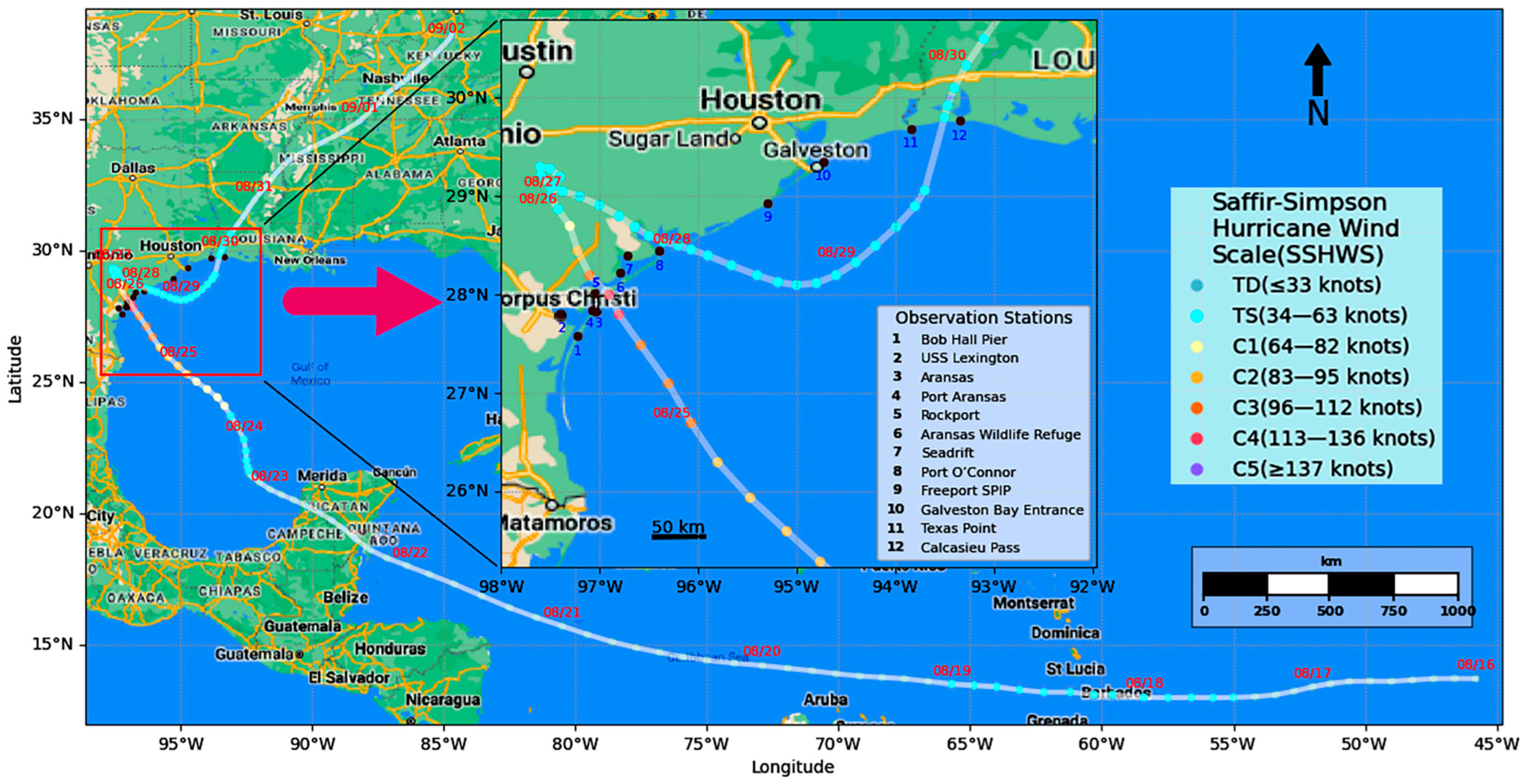

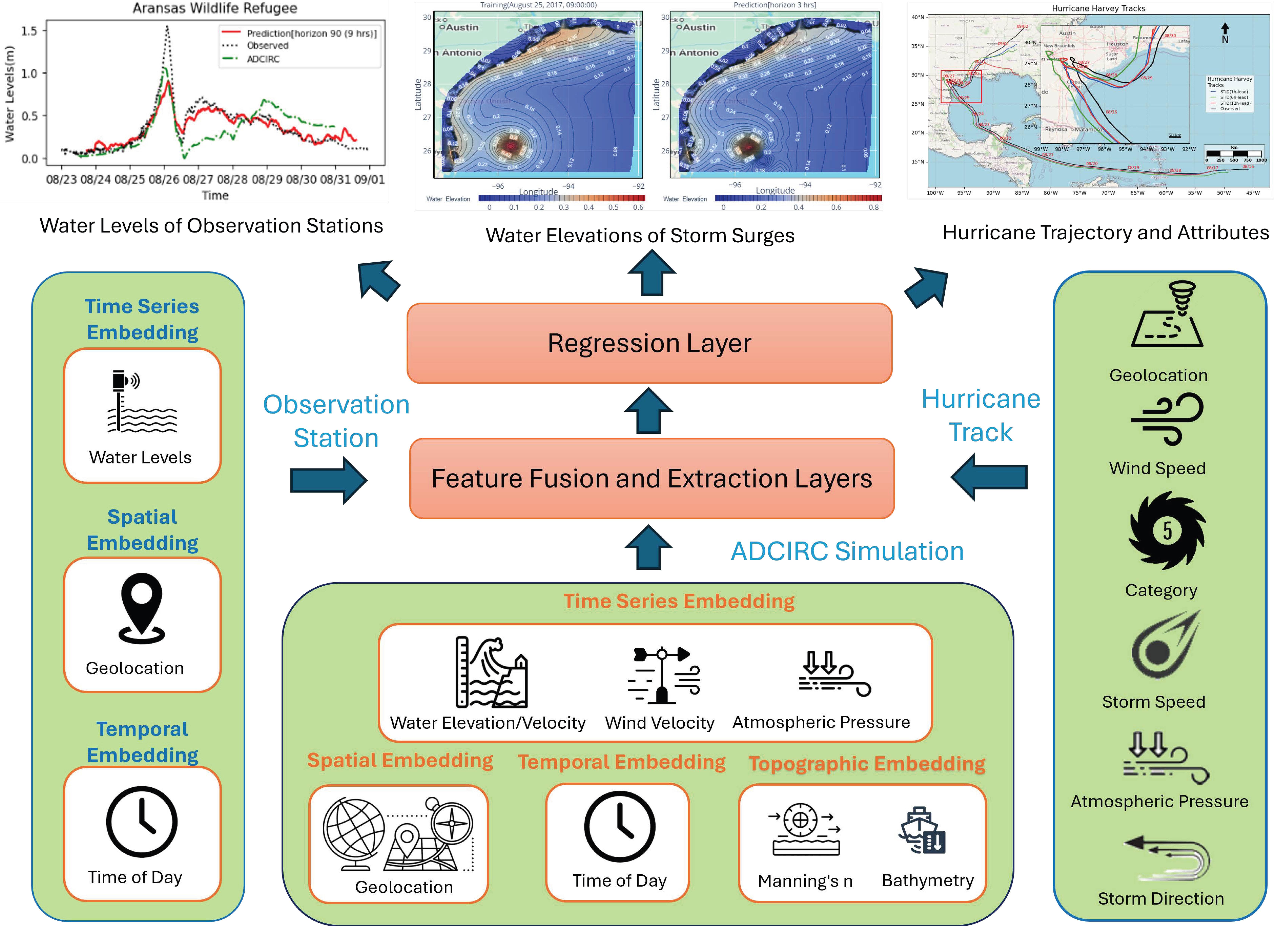

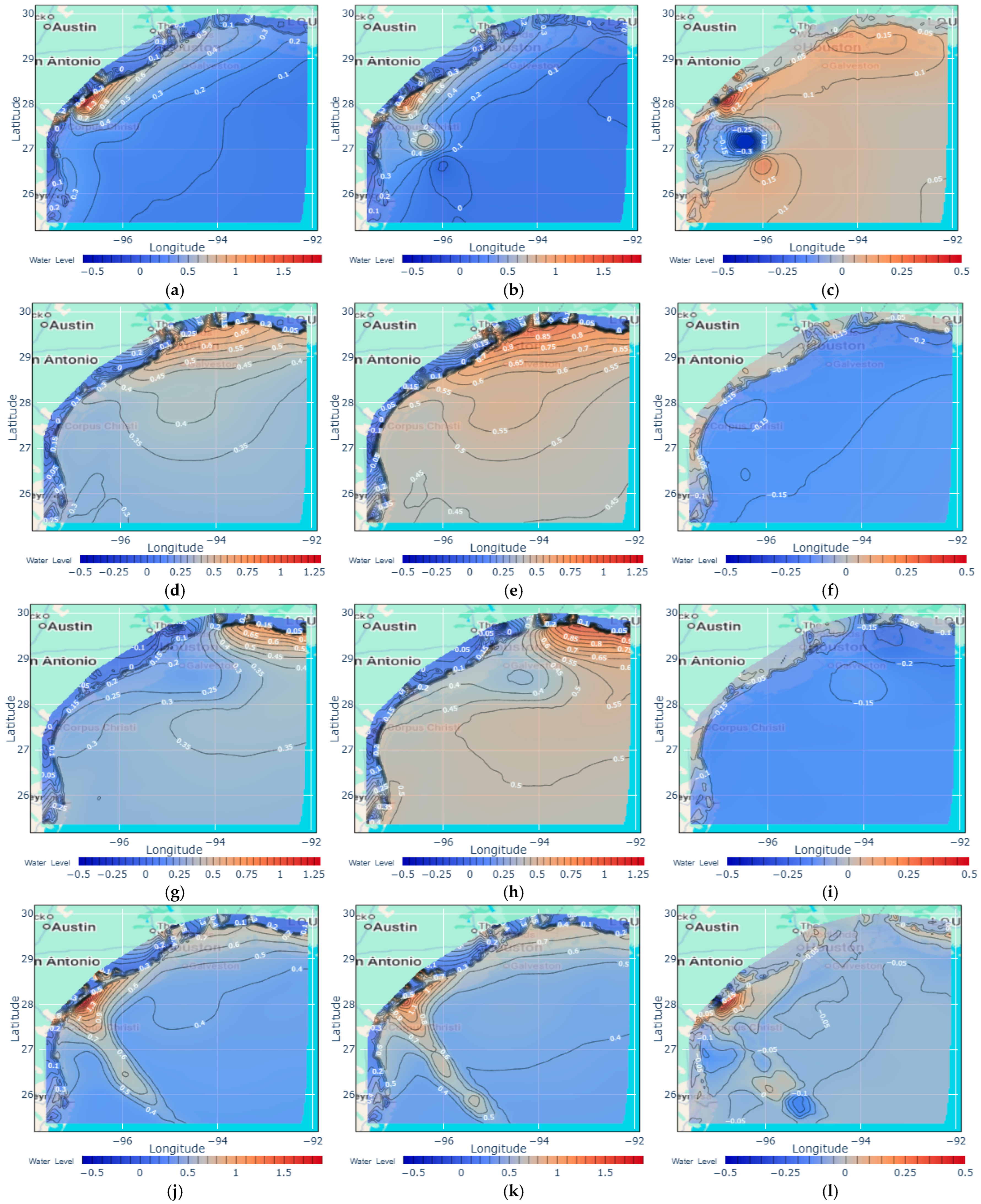
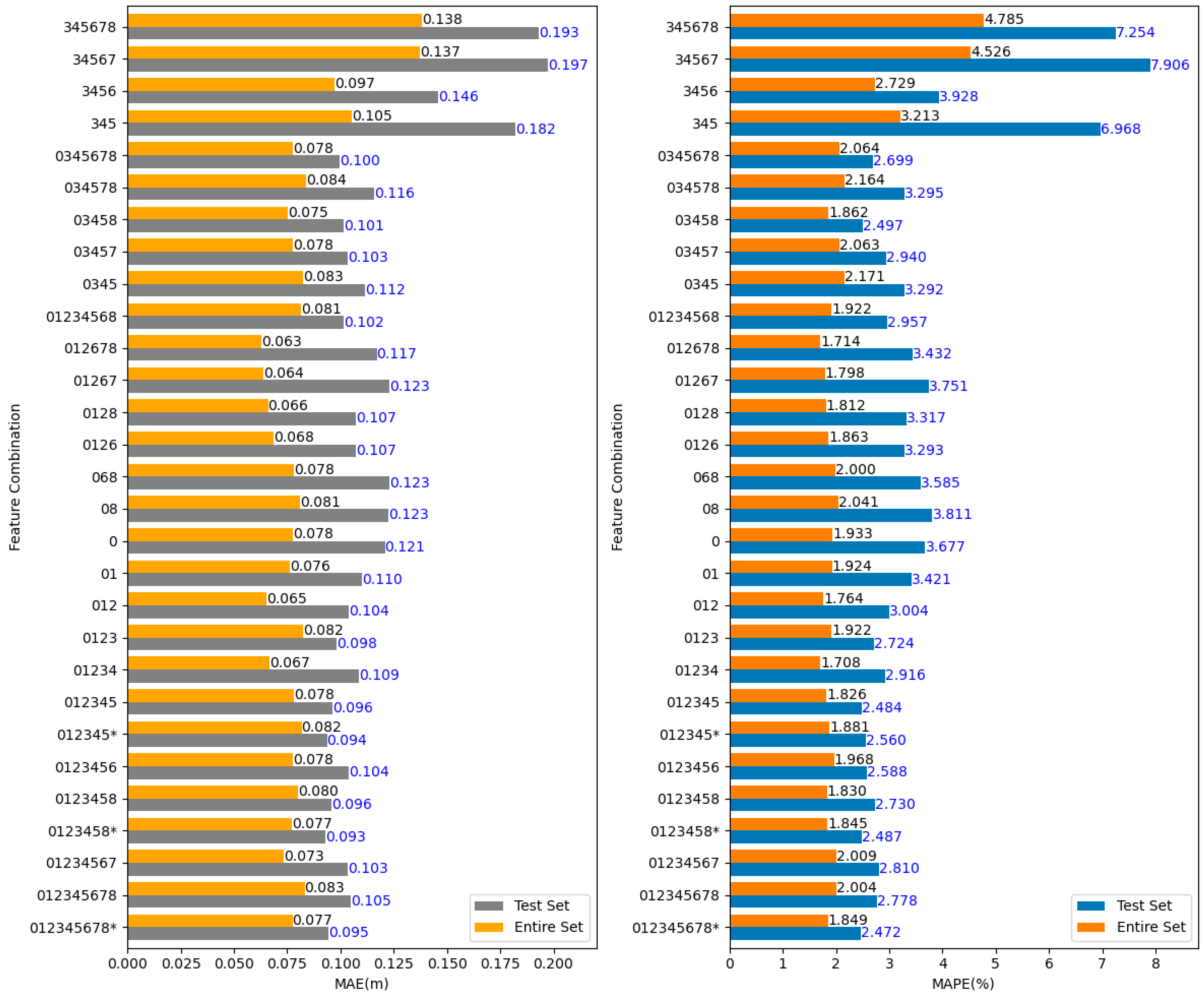
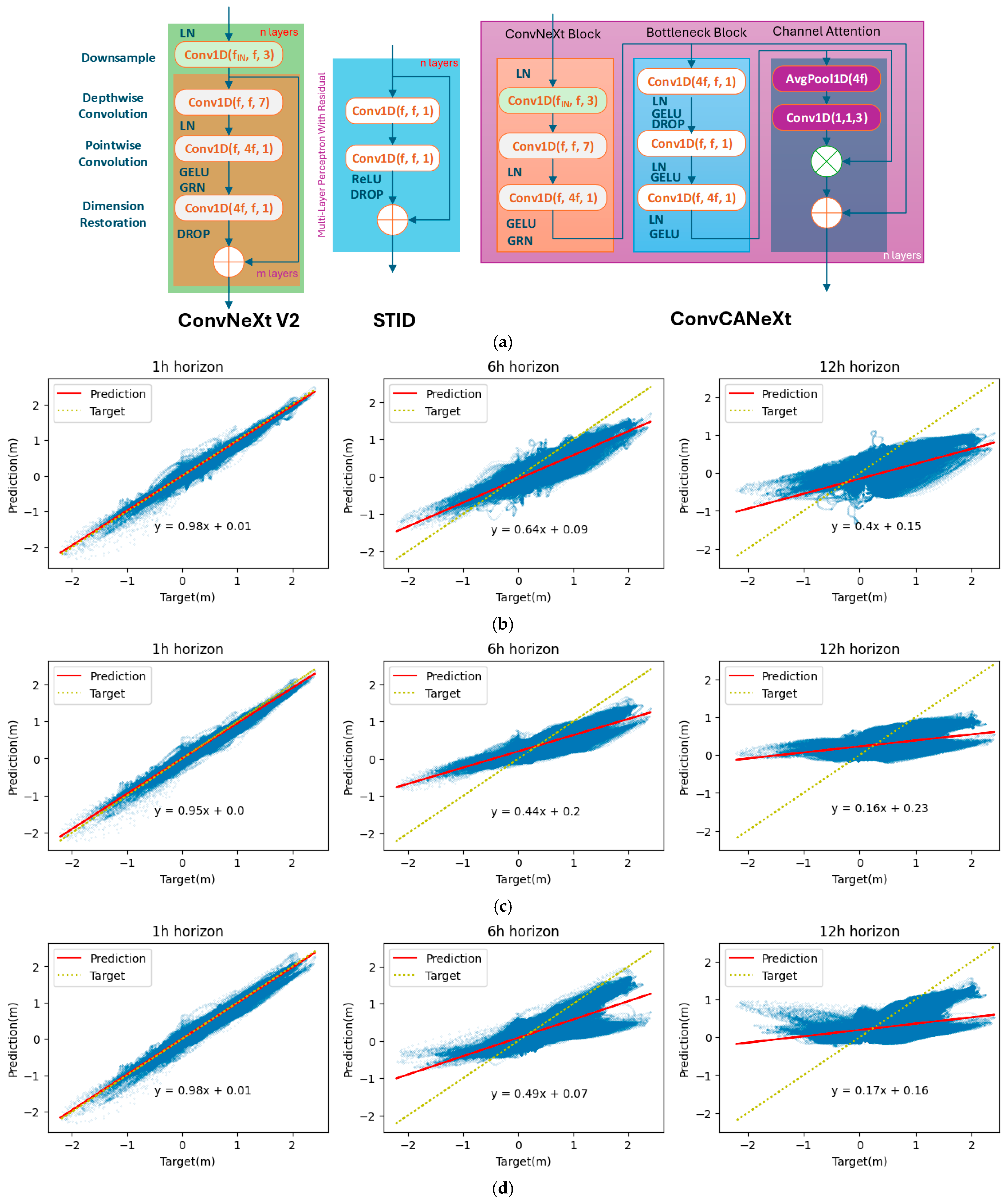

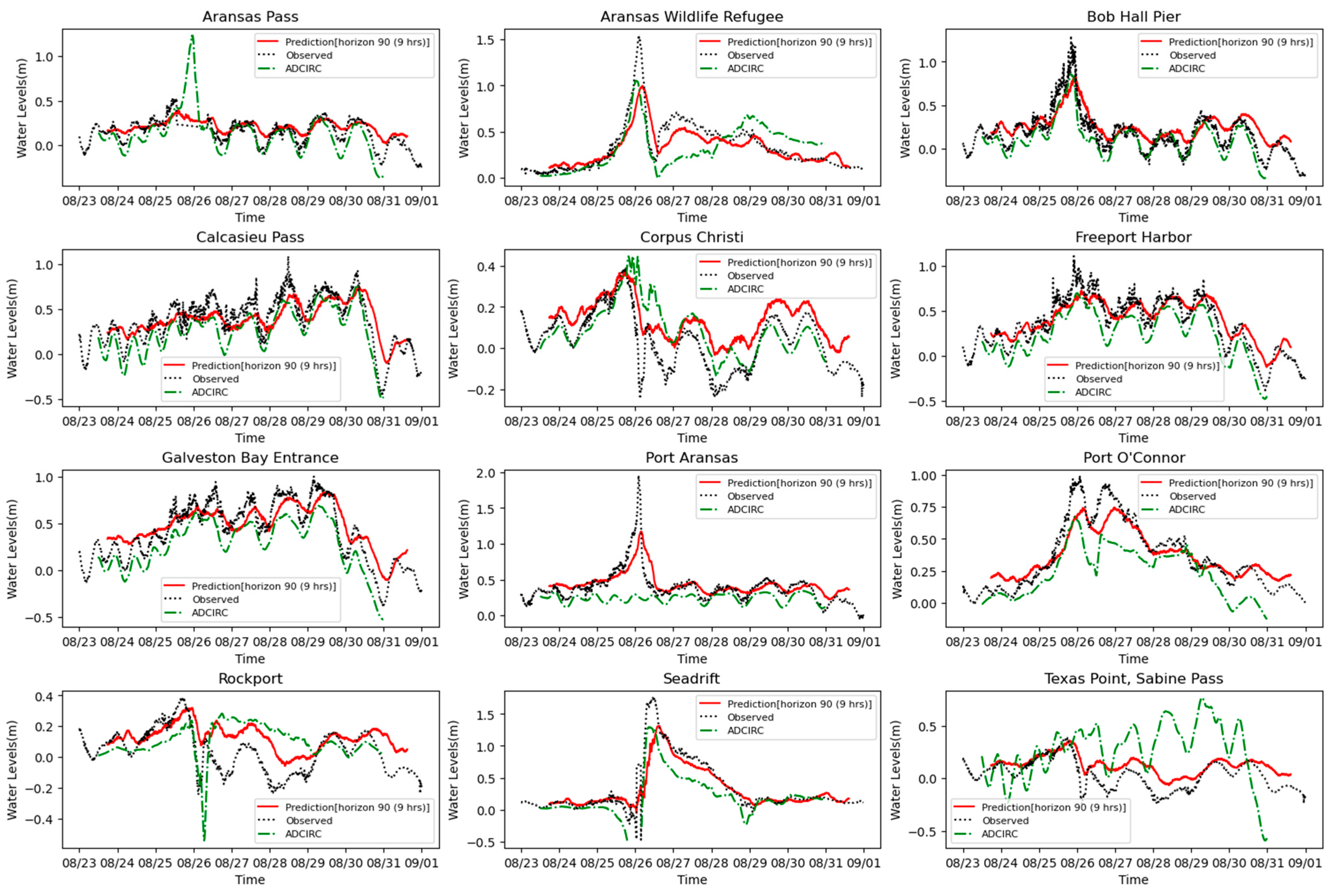
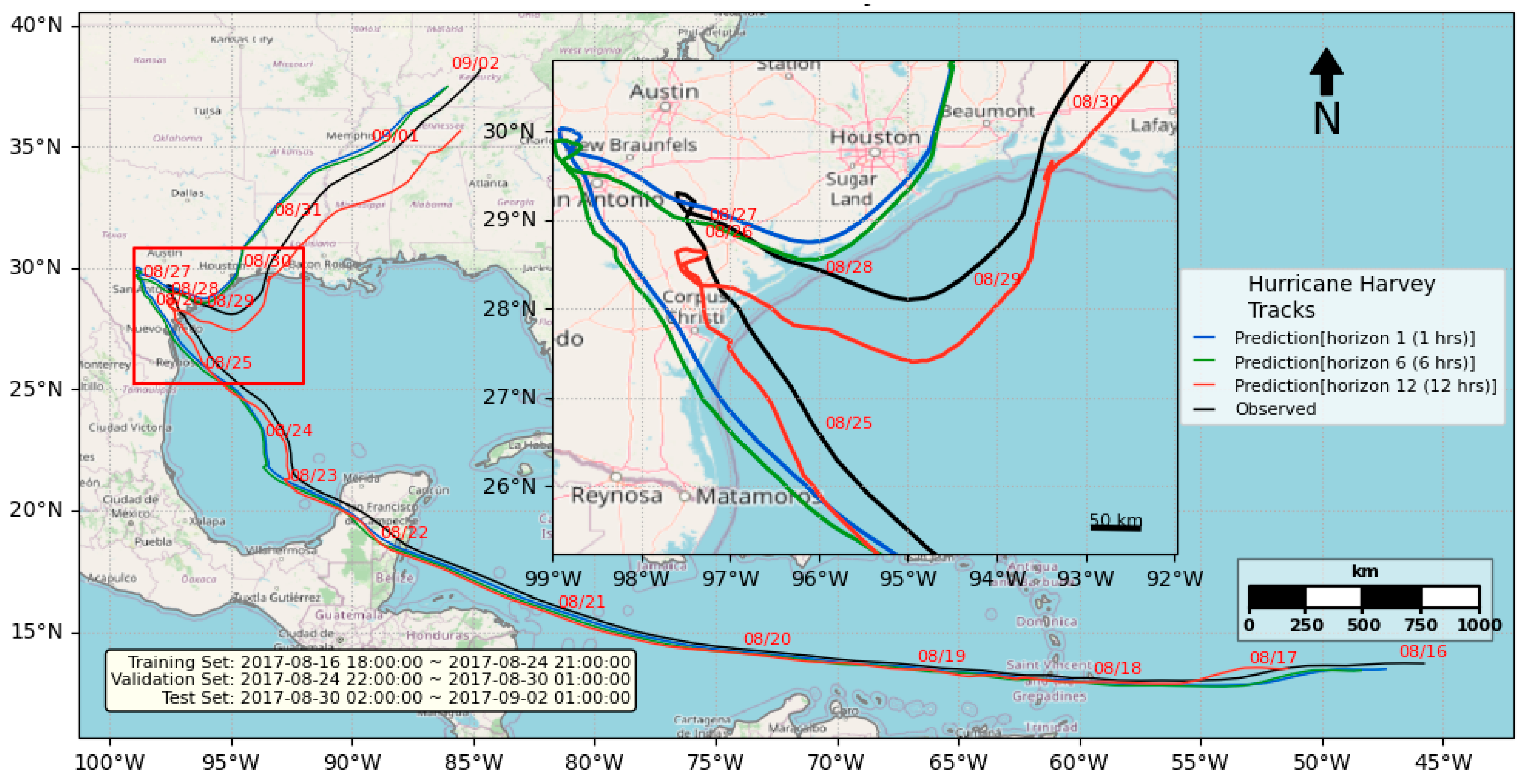
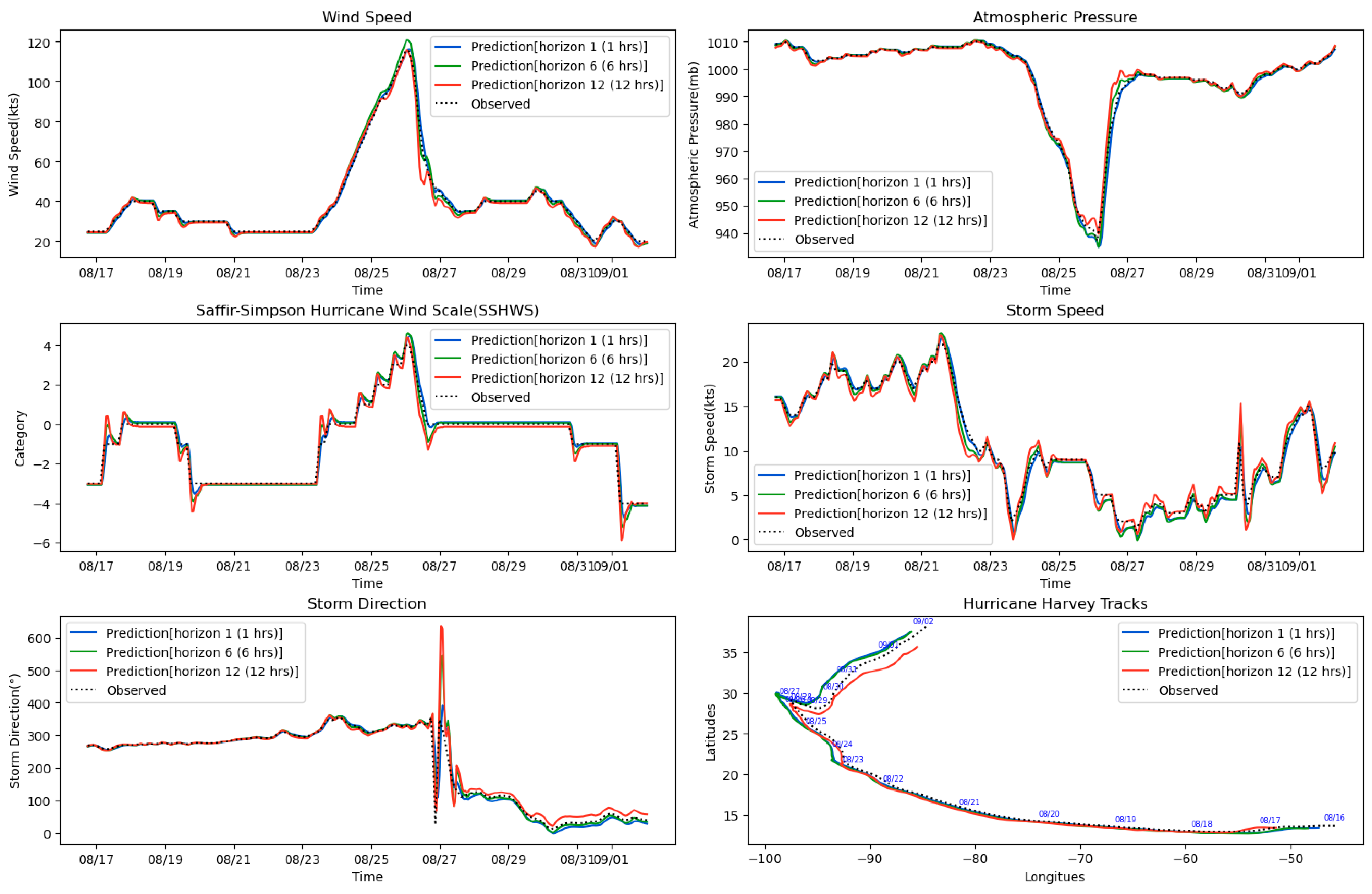
| Station ID | NOAA ID | Lon | Lat | Bathymetry (m) | Name |
|---|---|---|---|---|---|
| 1 | 8775870 | −97.2167 | 27.58 | −3.02 | Bob Hall Pier, TX, USA |
| 2 | 8775296 | −97.39 | 27.812 | −10.46 | USS Lexington, Corpus Christi Bay, TX, USA |
| 3 | 8775241 | −97.0383 | 27.837 | −10.23 | Aransas, Aransas Pass, TX, USA |
| 4 | 8775237 | −97.0733 | 27.841 | −12.05 | Port Aransas, TX, USA |
| 5 | 8774770 | −97.0461 | 28.022 | −2.35 | Rockport, TX, USA |
| 6 | 8774230 | −96.7945 | 28.222 | −0.87 | Aransas Wildlife Refuge, TX, USA |
| 7 | 8773037 | −96.7131 | 28.402 | −0.76 | Seadrift, TX, USA |
| 8 | 8773701 | −96.395 | 28.447 | −3.11 | Port O’Connor, TX, USA |
| 9 | 8772471 | −95.295 | 28.935 | −9.49 | Freeport SPIP, Freeport Harbor, TX, USA |
| 10 | 8771341 | −94.7245 | 29.354 | −10.25 | Galveston Bay Entrance, North Jetty, TX, USA |
| 11 | 8770822 | −93.8417 | 29.69 | −5.3009 | Texas Point, Sabine Pass, TX, USA |
| 12 | 8768094 | −93.3433 | 29.768 | −5.9747 | Calcasieu Pass, LA, USA |
| Model Component | Input Features | Output Features | |||
|---|---|---|---|---|---|
| Surrogate model of ADCIRC+SWAN | 88,091 | 10 | 1 | Time Series (Water elevation, water velocity u, water velocity v, wind velocity u, wind velocity v, atmospheric pressure), Static Features (bathymetry, Mannings’ n), Spatial embedding, Temporal embedding | Water elevation |
| Water levels of observation stations | 12 | 4 | 1 | Time Series (Water levels), Spatial embedding, Temporal embedding | Water levels |
| Hurricane tracks and attributes | 1 | 7 | 7 | Longitude, latitude, wind speed, storm speed, atmospheric pressure, hurricane category, storm direction | Same as input features |
| Model Component | Data Split Ratio | Training | Validation | Test |
|---|---|---|---|---|
| Surrogate model of ADCIRC+SWAN | 0.3:0.3:0.4 | 54 h; from 23 August 2017, 12:00:00 to 25 August 2017, 18:00:00 | 54 h; from 25 August 2017, 19:00:00 to 28 August 2017, 00:00:00 | 72 h; from 28 August 2017, 01:00:00 to 31 August 2017, 00:00:00 |
| Water levels of observation stations | 0.3:0.3:0.4 | 648 data points; from 23 August 2017, 00:00:00 to 25 August 2017, 16:42:00 | 648 data points; from 25 August 2017, 16:48:00 to 28 August 2017, 09:30:00 | 864 data points; from 28 August 2017 09:36:00 to 31 August 2017 23:54:00 |
| Hurricane tracks and attributes | 0.5:0.3:0.2 | 208 data; from 16 August 2017, 06:00:00 to 24 August 2017, 22:00:00 | 124 data; from 24 August 2017, 22:00:00 to 30 August 2017, 02:00:00 | 83 data; from 30 August 2017 03:00:00 to 2 September 2017 12:00:00 |
Disclaimer/Publisher’s Note: The statements, opinions and data contained in all publications are solely those of the individual author(s) and contributor(s) and not of MDPI and/or the editor(s). MDPI and/or the editor(s) disclaim responsibility for any injury to people or property resulting from any ideas, methods, instructions or products referred to in the content. |
© 2025 by the authors. Licensee MDPI, Basel, Switzerland. This article is an open access article distributed under the terms and conditions of the Creative Commons Attribution (CC BY) license (https://creativecommons.org/licenses/by/4.0/).
Share and Cite
Hou, J.; Akbar, M.K.; Samad, M.D.; Ouyang, L. Spatiotemporal Deep Learning to Forecast Storm Surge Water Levels and Storm Trajectory: Case Study Hurricane Harvey. J. Mar. Sci. Eng. 2025, 13, 1780. https://doi.org/10.3390/jmse13091780
Hou J, Akbar MK, Samad MD, Ouyang L. Spatiotemporal Deep Learning to Forecast Storm Surge Water Levels and Storm Trajectory: Case Study Hurricane Harvey. Journal of Marine Science and Engineering. 2025; 13(9):1780. https://doi.org/10.3390/jmse13091780
Chicago/Turabian StyleHou, Junqin, Muhammad K. Akbar, Manar D. Samad, and Lizhi Ouyang. 2025. "Spatiotemporal Deep Learning to Forecast Storm Surge Water Levels and Storm Trajectory: Case Study Hurricane Harvey" Journal of Marine Science and Engineering 13, no. 9: 1780. https://doi.org/10.3390/jmse13091780
APA StyleHou, J., Akbar, M. K., Samad, M. D., & Ouyang, L. (2025). Spatiotemporal Deep Learning to Forecast Storm Surge Water Levels and Storm Trajectory: Case Study Hurricane Harvey. Journal of Marine Science and Engineering, 13(9), 1780. https://doi.org/10.3390/jmse13091780






